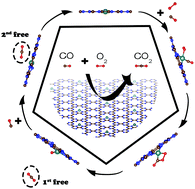Pd/Pt embedded CN monolayers as efficient catalysts for CO oxidation†
Abstract
Single atom catalysts (SACs) based on 2D materials have been identified to be efficient in many catalytic reactions. In this work, the catalytic performance of Pd/Pt embedded planar carbon nitride (CN) for CO oxidation has been investigated via spin-polarized density functional theory calculations. We find that Pd/Pt can be firmly anchored in the porous CN monolayer due to the strong hybridization between Pd/Pt-d orbitals and adjacent N-2p orbitals. The resulting high adsorption energy and large diffusion barrier of Pd/Pt ensures the remarkable stability of the catalyst Pd/Pt@CN during the CO oxidation reaction. The three distinct CO reaction mechanisms, namely, Eley–Rideal (ER), Langmuir–Hinshelwood (LH), and tri-molecular Eley–Rideal (TER), are taken into consideration comparatively. Intriguingly, the oxidation reaction on Pd@CN prefers to proceed through the less common TER mechanism, where two CO molecules and one O2 molecule need to cross a small reaction barrier of 0.48 eV, and finally dissociate into two CO2 molecules. However, the LH mechanism is the most relevant one on Pt@CN with a rate-limiting reaction barrier of 0.68 eV. Moreover, the origin of the SAC’s reactivity enhancement is the electronic “acceptance–donation” interaction caused by orbital hybridization between Pd/Pt and preadsorbed O2/CO. Our findings are expected to widen the catalytic application of carbon-based 2D materials.



 Please wait while we load your content...
Please wait while we load your content...